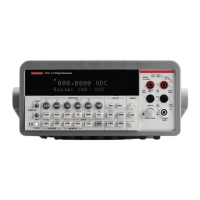Thermal EMFs
Thermal EMFs (thermoelectric potentials) are generated by thermal differences between the
junctions of dissimilar metals. These can be large compared to the signal that the Model 2000
can measure. Thermal EMFs can cause the following conditions:
• Instability or zero offset is much higher than expected.
• The reading is sensitive to (and responds to) temperature changes. This effect can be
demonstrated by touching the circuit, by placing a heat source near the circuit, or by a
regular pattern of instability (corresponding to changes in sunlight or the activation of
heating and air conditioning systems).
To minimize the drift caused by thermal EMFs, use copper leads to connect the circuit to the
Model 2000. A banana plug generates a few microvolts. A clean copper conductor such as #10
bus wire is ideal for this application. The leads to the input may be shielded or unshielded, as
necessary. Refer to “Shielding”.
Widely varying temperatures within the circuit can also create thermal EMFs. Therefore,
maintain constant temperatures to minimize these thermal EMFs. A shielded enclosure around
the circuit under test also helps by minimizing air currents.
The REL control can be used to null out constant offset voltages.
NOTE Additional thermals may be generated by the optional scanner cards.
2-20 Basic Measurements

